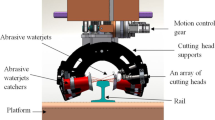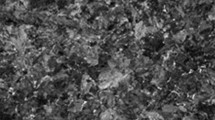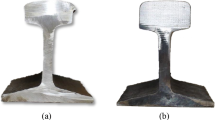Abstract
To investigate the rail repair process based on high-pressure abrasive water jet, simulation analysis of its machining process is carried out based on smoothed particle hydrodynamics with finite element method (SPH-FEM). First, through the water jet cutting experiment, analysis of simulation data and experimental results are compared, and the results are basically the same in terms of values and trends. The depth of cut decreases with the increase of transverse speed, increases with the increase of abrasive flow, and tends to increase and then decrease with the jet pressure and target distance. Then, the rail top surface is repaired by high-pressure abrasive water jet technology, and the experimental results show that the repaired rail surface fully meets the rail grinding and repair standards. The repaired rail surface roughness of 2.648 μm is better than the rail milling train repair index value of 56.2%, which verifies the feasibility and effectiveness of rail repair based on high-pressure abrasive water jet technology.
















Similar content being viewed by others
Data availability
The availability of data and materials has not changed and is still not available.
Code availability
Not applicable.
References
Fan WG, Liu YM, Li JY (2018) Development status and prospect of high-speed railway rail grinding technology. J Mech Eng 54(22):184–193
Li ZQ, Zhao PJ, Song YX, Sun T (2016) Research status of micro-abrasive water jet machining technology. Nanotechnol Precis Eng 14(02):134–144
Zhang ZY, Shang W, Ding HH, Guo J, Wang HY, Liu QY, Wang WJ (2016) Thermal model and temperature field in rail grinding process based on a moving heat source. Appl Therm Eng 106:855–864
Steenbergen M (2016) Rolling contact fatigue in relation to rail grinding. Wear 356-357:110–121
Santa J, Toro A, Lewis R (2016) Correlations between rail wear rates and operating conditions in a commercial railroad. Tribol Int 95:5–12
Kubin W, Daves W, Stock R (2019) Analysis of rail milling as a rail maintenance process: simulations and experiments. Wear 438-439:203029
Cui HY, Pan C, Ji HH, He YL (2018) Modeling and optimization of the milling cutter group for rail milling train. J Railw Sci Eng 15(05):1318–1322
Kmec J, Gombár M, Harničárová M, Valíček J, Kušnerová M, Kříž J, Kadnár M, Karková M, Vagaská A (2020) The predictive model of surface texture generated by abrasive water jet for austenitic steels. Appl Sci 10(9):3159
Cai C, Wang X, Yuan X, Kang Y, Wang Z, Huang M, Chen H (2019) Experimental investigation on perforation of shale with ultra-high pressure abrasive water jet: shape, mechanism and sensitivity. J Nat Gas Sci Eng 67:196–213
Tripathi R, Hloch S, Chattopadhyaya S, Klichová D, Ščučka J, Das AK (2020) Application of the pulsating and continuous water jet for granite erosion. Int J Rock Mech Min Sci 126:104209
Ashok Kumar U, Mehtab Alam S, Laxminarayana P (2020) Influence of abrasive water jet cutting on glass fibre reinforced polymer (GFRP) composites. Mater Today: Pro 27:1651–1654
Jiang YL, Zeng JJ, Xu CJ, Xiong FY, Pan YC, Chen XS, Lei ZX (2022) Experimental study on TBM cutter penetration damage process of highly abrasive hard rock pre-cut by high-pressure water jet. Bull Eng Geol Env 81:511
Mieszala M, Torrubia PL, Axinte DA, Schwiedrzik JJ, Guo Y, Mischler S, Michler J, Philippe L (2017) Erosion mechanisms during abrasive waterjet machining: model microstructures and single particle experiments. J Mater Process Technol 247:92–102
Kumar A, Singh H, Kumar V (2017) Study the parametric effect of abrasive water jet machining on surface roughness of Inconel 718 using RSM-BBD techniques. Mater Manuf Processes 33(13):1483–1490
Yu Y, Sun T, Yuan Y, Gao H, Wang X (2020) Experimental investigation into the effect of abrasive process parameters on the cutting performance for abrasive waterjet technology: a case study. Int J Adv Manuf Technol 107(5-6):2757–2765
Aydin G, Karakurt I, Hamzacebi C (2014) Artificial neural network and regression models for performance prediction of abrasive waterjet in rock cutting. Int J Adv Manuf Technol 75(9-12):1321–1330
Kantha Babu M, Krishnaiah Chetty OV (2006) A study on the use of single mesh size abrasives in abrasive waterjet machining. Int J Adv Manuf Technol 29(5):532–540
Yuvaraj N, Pradeep KM (2017) Study and evaluation of abrasive water jet cutting performance on AA5083-H32 aluminum alloy by varying the jet impingement angles with different abrasive mesh sizes. Mach Sci Technol 21(3):385–415
Li M, Huang M, Yang X, Li S, Wei K (2018) Experimental study on hole quality and its impact on tensile behavior following pure and abrasive waterjet cutting of plain woven CFRP laminates. Int J Adv Manuf Technol 99:2481–2490
Perec A (2018) Experimental research into alternative abrasive material for the abrasive water-jet cutting of titanium. Int J Adv Manuf Technol 97(1-4):1529–1540
Kumaran ST, Ko TJ, Uthayakumar M, Islam MM (2017) Prediction of surface roughness in abrasive water jet machining of CFRP composites using regression analysis. J Alloys Compd 724:1037–1045
Du MM, Wang HJ, Dong HY, Guo YJ, Ke YL (2022) Numerical research on multi-particle movements and nozzle wear involved in abrasive waterjet machining. Int J Adv Manuf Technol 117(9-10):2845–2858
Liu Y, Zhao Y, Yoshigoe K, Zhang S, Chen M (2021) Simulating a high-speed abrasive particle impacting on a tensile block using SPH-FEM. Int J Adv Manuf Technol 116(9-10):2835–2845
Feng L, Liu GR, Li Z, Dong X, Du M (2018) Study on the effects of abrasive particle shape on the cutting performance of Ti-6Al-4V materials based on the SPH method. Int J Adv Manuf Technol 101(9-12):3167–3182
Du M, Wang H, Dong H, Guo Y, Ke Y (2020) Numerical research on kerf characteristics of abrasive waterjet machining based on the SPH-DEM-FEM approach. Int J Adv Manuf Technol 111(11-12):3519–3533
Tian SL, Chen XA, Wu PF (2021) Research on flexible loading system of high-speed motorized spindles based on high-pressure water jet. J Mech Eng 57(13):36–44
Yin DY, Chen XC, Bao JS (2021) Research on milling technology of 3D braided composites based on abrasive water jet. J Mech Eng 57(05):273–280
Dong X, Liu YQ, Duan X (2020) Numerical simulation of multi-shot shot peening models and residual stress field of premixed water jet. J Mech Eng 56(04):224–232
Cai ZG, Chen XC, Wang D, Bao JS (2020) Research on water jet drilling technology for carbon-carbon composites. J Mech Eng 55(03):226–232
Zhang XZ, Wisniewski P, Dykas S, Zhang GJ (2021) Permeability enhancement properties of high-pressure abrasive water jet flushing and its application in a soft coal seam. Front Energy Res 9:679623
Liu S, Cui Y, Chen Y, Guo C (2019) Numerical research on rock breaking by abrasive water jet-pick under confining pressure. Int J Rock Mech Min Sci 120:41–49
Karas A, Ameur H, Mazouzi R, Kamla Y (2020) Determination of the dynamic characteristics of the abrasive water jet for process manufacturing. Int J Adv Manuf Technol 110(1-2):101–112
Zuo W, Huang C, Liu Y, Han H, Hao F, Zhao F, Huang F (2020) Analysis and modeling of particle velocities in premixed abrasive water jets. Geofluids 2020:1–9
CANNON DF, EDEL K-O, GRASSIE SL, SAWLEY K. (2003) Rail defects: an overview. Fatigue Fract Eng Mater Struct 26(10):865–886
Fan WG, Liu YM, Li JY (2018) Development status and prospect of rail grinding technology for high speed railway. J Mech Eng 54(22):184–193
Zhu HY, Yuan Y, Xiao Q, Li J, Zheng YX (2021) Res Progress on Rail Corrugation 21(03):110–133
Yu F, Wang JM, Liu FH (2011) Numerical simulation of single particle acceleration process by SPH coupled FEM for abrasive waterjet cutting. Int J Adv Manuf Technol 59(1-4):193–200
Ma L, Bao R, Guo Y (2008) Waterjet penetration simulation by hybrid code of SPH and FEA. Int J Impact Eng 35(9):1035–1042
Momber AW, Kovacevic R (1998) Principles of abrasive water jet machining. Springer, Berlin
Railway C (2014) Measures for the management of high-speed railway rail grinding: Tie Zongyun [2014] 357,. China Railway Press
Funding
This work was supported by the Revitalization of Liaoning Talent Program of Liaoning Province (XLYC1802038) (XLYC1807211) and the Shenyang High-Level Talent Program of Shenyang (RC190148)
Author information
Authors and Affiliations
Contributions
All authors contributed to the study conception and design. The material preparation was performed by Guo-zhe Yang and Wei-jun Liu. The experiment and data collection were performed by Guo-zhe Yang, Tong-ming Liu, and Qing-ze Tan. The analysis was performed by Bo-xue Song and Zi-sheng Wang. The first draft of the manuscript was written by Xing-yu Jiang, and all authors commented on previous versions of the manuscript. All authors read and approved the final manuscript.
Corresponding author
Ethics declarations
Ethics approval
The work does not contain libelous or unlawful statements and does not infringe on the rights of others, or contains material or instructions that might cause harm or injury.
Consent to participate
The authors consent to participate.
Consent for publication
All authors agree to transfer copyright of this article to the publisher.
Conflict of interest
The authors declare no competing interests.
Additional information
Publisher’s note
Springer Nature remains neutral with regard to jurisdictional claims in published maps and institutional affiliations.
Rights and permissions
Springer Nature or its licensor (e.g. a society or other partner) holds exclusive rights to this article under a publishing agreement with the author(s) or other rightsholder(s); author self-archiving of the accepted manuscript version of this article is solely governed by the terms of such publishing agreement and applicable law.
About this article
Cite this article
Yang, Gz., Liu, Tm., Jiang, Xy. et al. Rail repair technology based on high-pressure abrasive water jet. Int J Adv Manuf Technol 131, 2295–2310 (2024). https://doi.org/10.1007/s00170-023-11307-2
Received:
Accepted:
Published:
Issue Date:
DOI: https://doi.org/10.1007/s00170-023-11307-2




